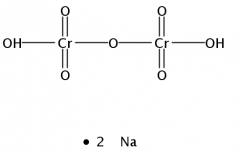Cr2Na2O7

1.有毒!长期吸入含六价铬的有毒产品,能破坏鼻黏膜,引起鼻黏膜和鼻中隔软骨穿孔,使呼吸器官受到损伤。皮肤接触重铬酸钠溶液和粉末时易引起铬疮和皮炎,甚至失明。因此,如有重铬酸钠溶液或粉末溅到皮肤上,应立即用大量水冲洗干净;如不慎溅入眼睛内,应立即用大量水冲洗15min以上,并滴入鱼肝油和30%磺胺乙酰溶液进行处理。误食铬盐会引起急性铬中毒,出现腹痛、呕吐、便血,严重者会出现血尿、抽搐、精神失常,应立即用亚硫酸钠溶液洗胃解毒,口服1%的氧化镁稀溶液,喝牛奶和蛋清等。
2.稳定性[11] 稳定
3.禁配物[12] 强还原剂、醇类、水、活性金属粉末、硫、磷、强酸
4.避免接触的条件[13] 潮湿空气
5.聚合危害[14] 不聚合
1.性状:橘红色结晶,易潮解。[1]
2.熔点(℃):357(无水)[2]
3.沸点(℃):400(分解)[]3
4.相对密度(水=1):2.52[4]
5.溶解性:溶于水,不溶于醇。[5]
1.有毒!长期吸入含六价铬的有毒产品,能破坏鼻黏膜,引起鼻黏膜和鼻中隔软骨穿孔,使呼吸器官受到损伤。皮肤接触重铬酸钠溶液和粉末时易引起铬疮和皮炎,甚至失明。因此,如有重铬酸钠溶液或粉末溅到皮肤上,应立即用大量水冲洗干净;如不慎溅入眼睛内,应立即用大量水冲洗15min以上,并滴入鱼肝油和30%磺胺乙酰溶液进行处理。误食铬盐会引起急性铬中毒,出现腹痛、呕吐、便血,严重者会出现血尿、抽搐、精神失常,应立即用亚硫酸钠溶液洗胃解毒,口服1%的氧化镁稀溶液,喝牛奶和蛋清等。
2.稳定性[11] 稳定
3.禁配物[12] 强还原剂、醇类、水、活性金属粉末、硫、磷、强酸
4.避免接触的条件[13] 潮湿空气
5.聚合危害[14] 不聚合
1.性状:橘红色结晶,易潮解。[1]
2.熔点(℃):357(无水)[2]
3.沸点(℃):400(分解)[]3
4.相对密度(水=1):2.52[4]
5.溶解性:溶于水,不溶于醇。[5]
1.急性毒性[6] LD50:50mg/kg(大鼠经口)
2.刺激性 暂无资料
3.致突变性[7] 微生物致突变:鼠伤寒沙门菌50μg/皿。DNA损伤:大鼠肝10μmol/L。姐妹染色单体交换:仓鼠肺140μg/L。
4.致癌性[8] IARC致癌性评论:组1,对人类是致癌物。
5.其他[9] 大鼠腹腔注射最低中毒剂量(TDLo):20mg/kg(染毒8周,雄性),影响精子生成。
1.生态毒性[10]
LC50:18~133mg/L(96h)(鱼)
IC50:0.58mg/L(72h)(藻类)
2.生物降解性 暂无资料
3.非生物降解性 暂无资料
| Name: | Sodium dichromate Material Safety Data Sheet |
| Synonym: | Sodium bichromate |
| CAS: | 10588-01-9 |
| CAS# | Chemical Name | content | EINECS# |
| 10588-01-9 | Sodium dichromate | 100 | 234-190-3 |
1.疏水参数计算参考值(XlogP):无
2.氢键供体数量:0
3.氢键受体数量:7
4.可旋转化学键数量:0
5.互变异构体数量:无
6.拓扑分子极性表面积124
7.重原子数量:11
8.表面电荷:0
9.复杂度:194
10.同位素原子数量:0
11.确定原子立构中心数量:0
12.不确定原子立构中心数量:0
13.确定化学键立构中心数量:0
14.不确定化学键立构中心数量:0
15.共价键单元数量:3